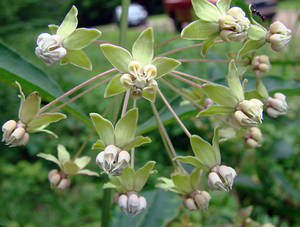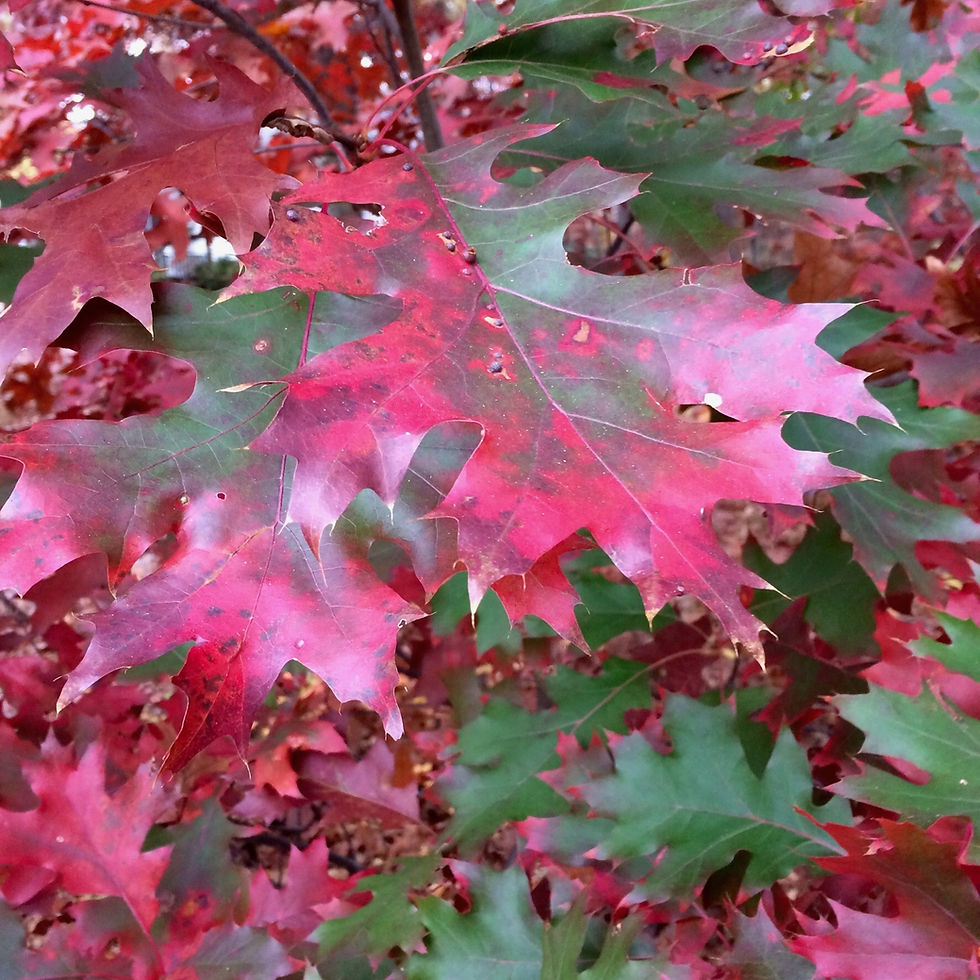Garden Obstacles: Picking the Right Milkweed
- Kimberly Simmen
- Dec 30, 2022
- 5 min read
Updated: Dec 30, 2022
I know it sounds weird calling milkweed a garden obstacle but many of you come to me looking for Asclepias syriaca (Common Milkweed) because you were told it is the best host plant for the Monarchs. While this may be true, it is also an aggressive garden thug. Nobody tells you this when you buy it, but I do. It is great in a meadow, along the roadside, or in a garden that is left alone to naturalize. So, if you have the space, you should plant common milkweed. If you do not have the space or are one to get upset when something grows a little out of hand, there many other milkweeds to choose from and they are all native to Long Island.
Several varieties grow in clumps instead of running. They all self-sow readily in the garden. If you want to control this, tie a string or put a rubber band around the seed pods. This will prevent them from going everywhere once they split open. You can save the seeds to share with friends or you can put them in different areas of the yard.
Please note: ALL milkweed contains cardiac glycosides and resinoids making them poisonous. It is toxic in large quantities only. The Monarch caterpillar ingests the milky sap and after the second instar, it becomes poisonous to predators.
I'll start with Common Milkweed and the other milkweed options will follow.
Asclepias syriaca - Common Milkweed
Needs full sun and grows 3-5' tall but may reach 8' tall in ideal conditions. The fragrant flowers may be white, pink, lavender, or purple and have a long bloom time of June through August. This makes it a superb nectar source for butterflies and bees. Native Americans use the fluffy floss as a fiber source. During WWII, it was used to make life jackets. Today it is farmed by people realizing its use in jackets, pillows, and comforters. Some like to plant it in a large container, but it will get out through the holes in the bottom and by seed. It is also the host plant for the Milkweed Tussock Moth. It spreads by rhizomes and seeds to form small to large colonies. Usually deer resistant.
Photos: Pink flower (Lucy Bradley, CC0), White flower (Douglas Goldman, USDA, CC BY-NC 4.0), Form with flower (Douglas Goldman, USDA, CC BY-NC 4.0), Spent seed pods (KMS Native Plants)
Asclepias exaltata - Poke Milkweed
This is a fun, slow-growing milkweed as it prefers partial shade (woodland edge). Tolerates full sun but the leaves will not get big. It does prefer rich, moist soil. Growing 2-6' tall and sometimes taller by 12-24" wide, it has been known to hybridize with Common Milkweed. The fragrant blooms from July through August attract a large number of native pollinators. Deer resistant but rabbits may nibble on it. The common name of Poke Milkweed comes from the look of the leaves as they resemble our native Pokeweed.
Photos: Flower (Steven Daniel), Form (Jacqueline Donnelly)
Asclepias incarnata ssp incarnata - Swamp Milkweed
This lovely milkweed grows 36-60" tall by 2-3' wide when mature. It does not run in the garden, as it is a clump grower, making it perfect for a mixed border or pond plant. Don't be thrown off by the common name of swamp milkweed as it will grow in average garden soil and tolerate a good amount of drought. Prefers full sun to partial shade. It is a another long bloomer starting in July and going through to September. If a mauve pink isn't your thing, it also comes in white. 'Ice Ballet' brings just as many polliantors in as the straight species. It is a nectar source for butterflies, bees, wasps and hummingbirds.
Photos (KMS Native Plants): Eastern Tiger Swallowtail nectaring on flower, Carpenter Bee nectaring on flower, Milkweed bug, White cultivar called 'Ice Ballet'
Asclepias incarnata ssp pulchra - Eastern Swamp Milkweed
This is one of my favorites for the garden! Just like the Swamp Milkweed above it is a clump grower and not a runner. The leaves are a bit different with a kind of hairy feel to them. The above milkweed has shinier leaves. Prefers full sun to partial shade and grows 3-5' tall and 2-3' wide in average to wet soil. Tolerates a bit of drought.Blooms July to September. A great nectar source for butterflies, bees, wasps, and hummingbirds.
Photos (KMS Native Plants): foliage, flower, Monarch butterfly, open seed pods
Asclepias purpurascens - Purple Milkweed*
Listed as Threatened*** in New York State
This beautiful plant with fragrant, purple flowers in June through July, needs a lot of room as it spreads by rhizomes and seeds to form colonies. Aggressive but not a total thug growing only 24-36" tall by 12-36" wide in dry to average soil. A great nectar source for butterflies, bees, wasps, and hummingbirds. Deer resistant.

Photo: Leaves, buds, flower (Katja Schulz, CC-BY-SA 2.0)
Asclepias tuberosa - Butterfly Weed
This is a fantastic milkweed for dry to average soils in full sun growing 12-24" tall by 12-24" wide, sometimes taller. The gorgeous orange flowers start in June and go through to August. Unlike other milkweeds, butterfly weed has a deep taproot that does not transplant easily. So make sure you pick its home before planting it. Another difference from other milkweeds is the lack of milky stems. It is usually deer resistant but sometimes they will browse. Self sows readily in the garden.
Photos (KMS Native Plants): Flowers with (if you look closely) tiny sweat bees, Flowers, Monarch caterpillar, Seed pods
Asclepias verticillata - Whorled Milkweed**
Listed as Rare* in New York State
This is another one of my favorites! The buds are plush pink and the fragrant white flowers in July through September are beautiful mixed with the threadleaf foliage. Grows 12-36" tall and 12-36" wide in full sun to partial sun in dry soil. It does spread by rhizomes and seed but it is not a thug. An excellent nectar source for butterflies, bees, and wasps.
Photos: Buds and flowers (KMS Native Plants)
Friend or Foe
Beware of this tropical beauty being sold as an annual here on Long Island. It is full of nectar and attracts a lot of pollinators, but if you want to help the Monarchs do not plant it. If you must plant it, then you must follow the rules. The plants must be cut back to the ground twice during the growing season to limit the spread of disease, and plants must be removed late in summer so as not to interfere with migration (Wheeler, 2018).
Asclepias curassavica - Tropical Milkweed

Photo: Great Golden Digger Wasp on tropical milkweed
I hope this helps clear up which milkweed you should plant in your garden. There are a few others that are native to Long Island but not as easy to come by like Asclepias rubra (Red Milkweed) and Asclepias viridiflora (Green Milkweed). Please also note Asclepias purpurascens (Purple Milkweed) is also not easy to find.
If you have any questions, please contact Kimberly at kmsnativeplants@gmail.com
*Rare plants are protected under New York State Environmental Conservation Law section 9-1503. Part (f) reads as follows: "It is a violation for any person, anywhere in the state to pick, pluck, sever, remove, damage by the application of herbicides or defoliants, or carry away, without the consent of the owner, any protected plant. Each protected plant so picked, plucked, severed, removed, damaged or carried away shall constitute a separate violation." At this time, the Atlas only identifies those species listed as threatened or endangered.
**Rare 1) 20 to 35 extant sites, or 2) 3,000 to 5,000 individuals statewide.
***Threatened 1) 6 to fewer than 20 extant sites, or 2) 1,000 to fewer than 3,000 individuals, or 3) restricted to not less than 4 or more than 7 U.S.G.S. 7 1/2 minute topographical maps, or 4) listed as threatened by the U. S. Department of the Interior, as enumerated in the Code of Federal Regulations 50 CFR 17.11.
References




















































Comments